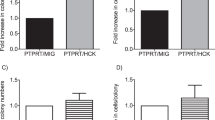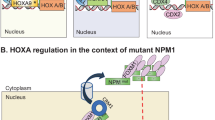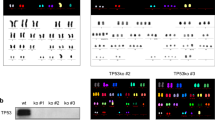Abstract
Expression of HoxaT and Hoxa9 is activated by proviral integration in BXH2 murine myeloid leukaemias. This result, combined with the mapping of the HOXA locus to human chromosome 7p15, suggested that one of the HOXA genes might be involved in the t(7;11)(p15;p15) translocation found in some human myeloid leukaemia patients. Here we show that in three patients with t(7;11), the chromosome rearrangement creates a genomic fusion between the HOXA9 gene and the nucleoporin gene NUP98 on chromosome 11 p15. The translocation produces an invariant chimaeric NUP98/HOXA9 transcript containing the amino terminal half of NUP98 fused in frame to HOXA9. These studies identify HOXA9 as an important human myeloid leukaemia gene and suggest an important role for nucleoporins in human myeloid leukaemia given that a second nucleoporin, NUP214, has also been implicated in human myeloid leukaemia.
This is a preview of subscription content, access via your institution
Access options
Subscribe to this journal
Receive 12 print issues and online access
$209.00 per year
only $17.42 per issue
Buy this article
- Purchase on Springer Link
- Instant access to full article PDF
Prices may be subject to local taxes which are calculated during checkout
Similar content being viewed by others
References
Rabbitts, T.H. Chromosomal translocations in human cancer. Nature. 372, 143–149 (1994).
Sandberg, A.A. The chromosomes in human cancer and leukemia 2nd edn. (Elsevier, New York, 1990).
Morris, C.M. et al. HRAS1 and INS genes are relocated but not structurally altered as a result of the t(7;11)(p15;p15) in a clone from a patient with acute myeloid leukaemia (M4). Br. J. Haemat. 71, 481–86 (1989).
Nakamura, T., Largaespada, D.A., Shaughnessy, Jr., J.D., Jenkins, N.A. & Copeland, N.G. Cooperative activation of Hoxa and Pbx1 -related genes in murine myeloid leukemias. Nature Genet. 12, 149–153 (1996).
Acampora, D. et al. The human HOX gene family. Nucl. Acids Res. 17, 10385–10402 (1989).
Iris, F.J.M. et al. Dense Alu clustering and a potential new member of the NFKB family within a 90 kilobase HLA Class III segment. Nature Genet. 3, 137–145 (1993).
Radu, A., Moore, M.S. & Blobel, G. The peptide repeat domain of nucleoporin Nup98 functions as a docking site in transport across the nuclear pore complex. Cell. 81, 215–222 (1995).
Benson, G.V., Nguyen, T-H.E. & Maas, R.L. The expression pattern of the murine Hoxa-10 gene and the sequence recognition of its homeodomain reveal specific properties of abdominal B-like genes. Mol. Cell. Biol. 15, 1591–1601 (1995).
Rubin, M.R. et al. Murine Hox-1.7 homeobox gne: Cloning, chromosomal location, and expression. Mol. Cell. Biol. 7, 3836–3841 (1987).
Silver, P A How proteins enter the nucleus. Cell 64, 489–497 (1991).
Burd, C.G. & Dreyfuss, G. Conserved structures and diversity of functions of RNA-binding proteins. Science 154, 1662–1665 (1994).
Fabre, E., Boelens, W.C., Wimmer, C., Mattaj, I.W. & Hurt, E.G. Nup145p is required for nuclear export of mRNA and binds homopolymeric RNA in vitro via a novel conserved motif. Cell 78, 275–289 (1994).
Barker, D., Holm, T. & White, R. A locus on chromosome 11 p with multiple restriction site polymorphisms. Am. J. Hum. Genet. 36, 1159–1171 (1984).
Koi, M. et al. Tumor cell growth arrest caused by subchromosomal transferable DNA fragments from chromosome 11. Science. 260, 361–364 (1993).
Tanigami, A. et al. Mapping of 262 DNA markers into 24 intervals on human chromosome 11. Am. J. Hum. Genet. 50, 56–64 (1992).
von Lindern, M. et al. The translocation (6;9), associated with a specific subtype of acute myeloid leukemia, results in the fusion of two genes, dek and can, and the expression of a chimeric, leukemia-specific dek-can mRNA. Mol. Cell. Biol. 12, 1687–1697 (1992).
Kraemer, D., Wozniak, R.W., Blobel, G. & Radu, A. The human CAN protein, a putative oncogene product associated with myeloid leukemogenesis, is a nuclear pore complex protein that faces the cytoplasm. Proc. Natl. Acad. Sci. USA 91, 1519–1523 (1994).
Fornerod, M. et al. Relocation of the carboxyterminal part of CAN from the nuclear envelope to the nucleus as a result of leukemia-specific chromosome rearrangements. Oncogene 10, 1739–1748 (1995).
von Lindern, M. et al. can, a putative oncogene associated with myeloid leukemogenesis, may be activated by fusion of its 3′ half to different genes: Characterization of the set gene. Mol. Cell. Biol. 12, 3346–3355 (1992).
Adachi, Y, Pavlakis, G. N. & Copeland, T.D. Identification and characterization of SET, a nuclear phosphoprotein encoded by the translocation break point in acute undifferentiated leukemia. J. Biol. Chem. 269, 2258–2262 (1994).
Ishimi, I. & Kikuchi, A. Identification and molecular cloning of a yeast homolog of nucleosome assembly protein I which facilitates nucleosome assembly in vitro. J. Biol. Chem. 266, 7025–7029 (1991).
Kwong, Y.L. & Chan, T.K. Translocation (7;11)(p15;p15) in acute myeloid leukemia M2: Association with trilineage myelodysplasia and giant dysplastic myeloid cells. Am. J. Hemat. 47, 62–64 (1994).
Hoovers, J.M.N. et al. Multiple genetic loci within 11p15 defined by Beckwith-Wiedemann syndrome rearrangement breakpoints and subchromosomal transferable fragments. Proc. Natl. Acad. Sci. USA(in the press).
Winqvist, R. et al. Loss of heterozygosity for chromosome 11 in primary human breast tumors is associated with poor survival after metastasis. Cancer Res. 55, 2660–2664 (1995).
Bepler, G. & Garcia-Blanco, M.A. Three tumor-suppressor regions on chromosome 11p identified by high-resolution deletion mapping in human non-small-cell lung cancer. Proc. Natl. Acad. Sci. USA. 91, 5513–5517 (1994).
Chan, S-K., Jaffe, L, Capovilla, M., Botas, J. & Mann, R.S. The DNA binding specificity of ultrabithorax is modulated by cooperative interactions with extradenticle, another homeoprotein. Cell 78, 603–615 (1994).
van Dijk, M.A. & Mure, C. extradenticle raises the DNA binding specificity of homeotic selector gene products. Cell 78, 617–624 (1994).
Shimamoto, T. et al. Late appearance of a Philadelphia translocation with minor-BCR/ABL transcript in a t(7;11)(p15;p15) acute myeloid leukemia. Leukemia. 9, 640–642 (1995).
Fujimura, T. et al. Two additional cases of acute myeloid leukemia with t(7;11)(p15;p15) having low neutophil alkaline phosphatase scores. Cancer Genet Cytogenet. 68, 143–146 (1993).
Sambrook, J., Fritsch, E.P. & Maniatis, T., Cloning: a Laboratory Manual. 2nd edn (Cold Spring Harbor, Laboratory Press, NewYork, 1989).
Jenkins, N.A., Copeland, N.G., Taylor, B.A., Bedigian, H.G. & Lee, B.K. Ecotropic murine leukemia virus DNA content of normal and lymphomatous tissues of BXH-2 recombinant inbred mice. J. Virol. 42, 379–388 (1982).
Glaser, T, Housman, D.E., Lewis, W.H., Gerhard, D .& Jones, C. A fine-structure deletion map of human chromosome 11 p; analysis of J1 series hybrids. Som. Cell Mol. Genet. 15, 477–501 (1989).
Redeker, E. et al. An integrated physical map of 210 markers assigned to the short arm of human chromosome 11. Genomics. 21, 538–550 (1994).
Devereux, J., Haeberli, P. & Smithies, O. A comprhensive set of sequence analysis programs for the VAX.Nucl. Acids Res. 12, 387–395 (1984).
Gish, W. & States, D.J. Identification of protein coding regions by database similarity search. Nature Genet. 3, 266–272 (1993).
Author information
Authors and Affiliations
Rights and permissions
About this article
Cite this article
Nakamura, T., Largaespada, D., Lee, M. et al. Fusion of the nucleoporin gene NUP98 to HOXA9 by the chromosome translocation t(7;11)(p15;p15) in human myeloid leukaemia. Nat Genet 12, 154–158 (1996). https://doi.org/10.1038/ng0296-154
Received:
Accepted:
Issue Date:
DOI: https://doi.org/10.1038/ng0296-154
This article is cited by
-
Regulation of HOX gene expression in AML
Blood Cancer Journal (2024)
-
Allogeneic stem cell transplantation can prolong the survival of patients with NUP98-rearranged acute myeloid leukemia
Bone Marrow Transplantation (2023)
-
Identification and analysis of methylation signature genes and association with immune infiltration in pediatric acute myeloid leukemia
Journal of Cancer Research and Clinical Oncology (2023)
-
Syngeneic leukemia models using lentiviral transgenics
Cell Death & Disease (2021)
-
Faggot cells in acute myeloid leukemia with t(7;11)(p15;p15) and NUP98-HOXA9 fusion
Annals of Hematology (2021)



